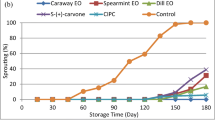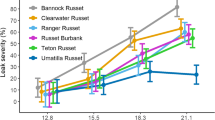Abstract
The potential for bacterial soft rot caused byErwinia carotovora in freshly inoculated potato tubers was reduced up to 99% by immersion for 5 min in solutions of sodium hypochlorite (chlorine bleach) containing up to 10,000 ppm chlorine. Reductions up to 93% were achieved using a combination treatment of immersion in 1% citric acid for 5 min followed by airdrying. Immersion treatment alone in 1% aqueous solutions of citric, acetic, ascorbic, or malonic acid also significantly reduced the soft rot potential. In contrast, no reductions accompanied treatment with solutions of potassium or calcium acetate. All treatments including the combination immersion/airdrying treatment were much less effective if tubers had been infiltrated initially with soft rotErwinia or had numerous mechanical injuries. If tubers had not been infiltrated with the causal organism, immersing them in 1% citric acid reduced the potential nearly as much as a similar treatment with 1000 ppm chlorine. A 30-sec immersion in the latter was less effective than a similar treatment with 500 ppm a.i. CGA 78039, an experimental bactericide. However, air-drying, coupled with provisions for keeping tuber surfaces free from moisture, remains the most effective means of reducing losses to bacterial soft rot.
Resumen
El potencial de la pudrición blanda bacteriana causada porErwinia carotovora, en tubérculos de papa inoculados recientemente, se redujo hasta en 99%, por la inmersión de los mismos, durante 5 minutos, en soluciones de hipoclorito de sodio (lejía) conteniendo hasta 10 000 ppm de cloro. Se lagraron reducciones hasta de 93% utilizando un tratamiento combinado de inmersión en ácido cítrico al 1% por 5 minutos, seguida por secado al aire. El tratamiento consistente en solo las inmersión en soluciones acuosas de ácidos cítricos, acético, ascórbico, y malónico al 1%, redujo también significativamente el potencial de la pudrición blanda. Por lo contrario, no se obtuvo reducción alguna por los tratamientos con soluciones de acetatos de potasio o de calcio. Todos los tratamientos, incluyendo la combinación de inmersión/secado al aire fueron menos efectivos cuando los tubérculos fueron infiltrados inicialmente con la Erwinia de la pudrición blanda o cuando los tubérculos tenían numerosas lesiones mecánicas. Si los tubérculos no habían sido infiltrados con el organismo causal, la inmersión en ácido cítrico al 1% redujo el potencial tanto como un tratamiento similar con 1000 ppm de cloro. Una inmersión por 30 segundos en el último tratamiento mencionado fue menos efectiva que un tratamiento similar con 500 ppm de un bactericida experimental como el CGA 78039. Sin embargo, el secado al aire, acompanado de precausiones para mantener las superficies de los tubérculos libres de humedad se mantiene como el medio más eficaz para reducir las pérdidas debidas a la pudrición blanda bacteriana.
Similar content being viewed by others
Literature Cited
Adams, M.J. 1975. Potato tuber lenticels: Susceptibility to infection byErwinia carotovora var.atroseptica andPhytophthora infestans. Ann Appl Biol 79:275–283.
Bartz, J.A. and A. Kelman. 1983. Chemical control of bacterial soft rot of potatoes. (Abstr.) Phytopathology 73:806.
Bartz, J.A. and A. Kelman. 1984. Effect of temperature on the inoculation of potato tubers by immersion in suspensions ofErwinia carotovora. Am Potato J 61:485–493.
Bartz, J.A. and A. Kelman. 1984. Inoculation of potato tubers withErwinia carotovora during simulated commercial washing and fluming practices. Am Potato J 61:495–507.
Bartz, J.A. and A. Kelman. 1985. Infiltration of lenticels of potato tubers byErwinia carotovora pv.carotovora under hydrostatic pressure in relation to bacterial soft rot. Plant Dis 69:69–74.
Bartz, J.A. and A. Kelman. 1985. Effect of air-drying on soft rot potential of potato tubers inoculated by immersion in suspension ofErwinia carotovora. Plant Dis 69:128–131.
Burton, W.G. and M.J. Wigginton. 1970. The effect of a film of water upon the oxygen status of a potato tuber. Potato Res 13:180–186.
Cates, F.B. and L.O. Van Blaricom. 1961. The effect of several compounds on postharvest decay of potatoes. Am Potato J 38:175–181.
Cromarty, R.W. and G.D. Easton. 1973. The incidence of decay and factors affecting bacterial soft rot of potatoes. Am Potato J 50:398–407.
De Boer, S.H. and A. Kelman. 1978. Influence of oxygen concentration and storage factors on susceptibility of potato tubers to bacterial soft rot (Erwinia carotovora). Potato Res 21:65–80.
Egli, T. and W. Zellen 1981. CGA 78039, a novel bactericide for the control of fireblight. Acta Horticulture 117:107–111.
Harris, R.I. 1978. A method for testing potential bactericides for the prevention of soft rotting of potato tubers. Potato Res 21:231–233.
Horsfall, J.G. and R.W. Barratt. 1945. An improved grading system for measuring plant diseases (Abstr.). Phytopathology 35:655.
Kelman, A., J.W. Baughn and E.A. Maher. 1978. The relationship of bacterial soft rot susceptibility to water status of potato tubers. (Abstr.) Phytopathol News 12:178.
Knowles, N.R., W.M. Iritani, L.D. Weiler and D.C. Gross. 1982. Susceptibility of potatoes to bacterial rot and weight loss as a function of wound-healing interval and temperature. Am Potato J 59:515–522.
Lapwood, D.H., P.J. Read and Janis Spokes. 1984. Methods for assessing the susceptibility of potato tubers of different cultivars to rotting byErwinia carotovora subspeciesatroseptica andcarotovora. Plant Pathol 33:13–20.
Lund, B.M. 1979. Bacterial soft-rot of potatoes.In: D.W. Lovelock and R. Davies (eds.)Plant Pathology. Soc Appl Bact Tech Ser No 12. Academic Press, London/NY.
Lund, B.M. and A. Kelman. 1977. Determination of the potential for development of bacterial soft rot of potatoes. Am Potato J 54:211–255.
Maher, E.A. and A. Kelman. 1985. Changes in populations ofErwinia carotovora in relation to the development of soft rot in wounded potato tissue. Proceedings Sixth International Conference on Plant Pathogenic Bacteria (in press).
McGuire, R.G. and A. Kelman. 1984. Reduced severity ofErwinia soft rot in potato tubers with increased calcium content. Phytopathology 74:1250–1256.
Perombelon, M.C.M. 1971. A quantitative method for assessing virulence ofErwinia carotovora var.carotovora andE. carotovora var.atroseptica and susceptibility of rotting of potato tuber tissue.In: H.P. Maas Geesteranus (ed.) Proceedings of the Third International Conference on Plant Pathogenic Bacteria. Wageningen, the Netherlands: Cent Agric Publ Doc PUDOC. 365 pp.
Perombelon, M.C.M. and A. Kelman. 1980. Ecology of the soft rotErwinias. Annu Rev Phytopathol 18:361–387.
Ruehle, G.D. 1940. Bacterial soft rot of potatoes in Southern Florida. Fla Agric Exp Stn Bull 348. 36 pp.
Sands, D.C. and J.L. Mclntyre. 1977. Citrate and tartrate sprays for reduction ofErwinia amylovora andPseudomonas syringae. Plant Dis Reptr 61:823–827.
Scholey, J., C. Marshall and R. Whitbread. 1968. A pathological problem associated with pre-packaging of potato tubers. Plant Pathol 17:135–139.
Tsuyumo, S. 1981. Non-toxic chemical control of soft rot disease.In: J.C. Lozano (ed.) Proceedings Fifth International Conference on Plant Pathogenic Bacteria. Cali, Colombia: Centro Internacional de Agricultura Tropical. 640 pp.
Wyatt, G.M. and B.M. Lund. 1981. The effect of antibacterial products on bacterial soft rot of potatoes. Potato Res 24:315–329.
Author information
Authors and Affiliations
Additional information
Journal Series Article 7062 of the Florida Agricultural Experiment Station, Gainesville.
Rights and permissions
About this article
Cite this article
Bartz, J.A., Kelman, A. Reducing the potential for bacterial soft rot in potato tubers by chemical treatments and drying. American Potato Journal 63, 481–493 (1986). https://doi.org/10.1007/BF02852943
Accepted:
Issue Date:
DOI: https://doi.org/10.1007/BF02852943




